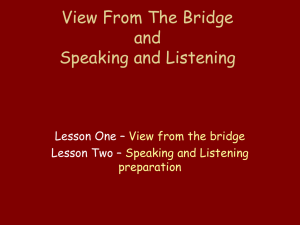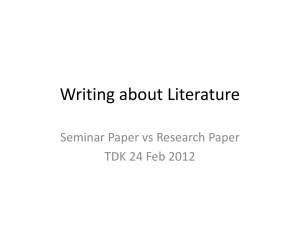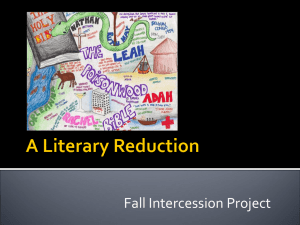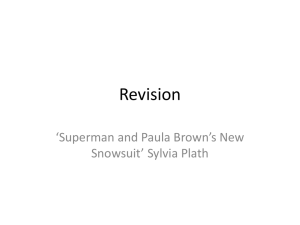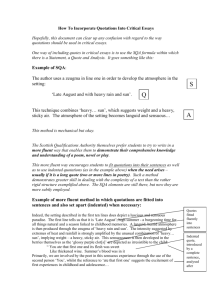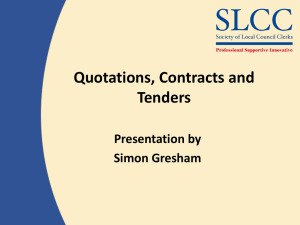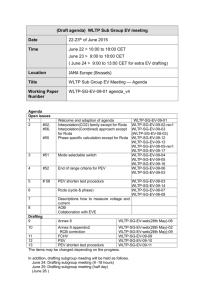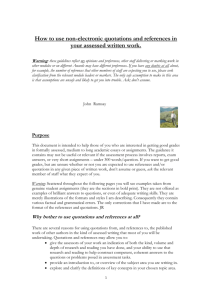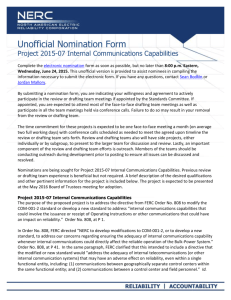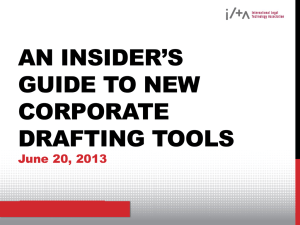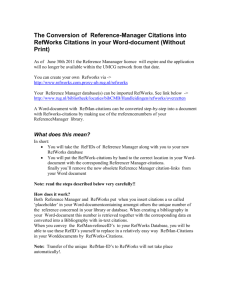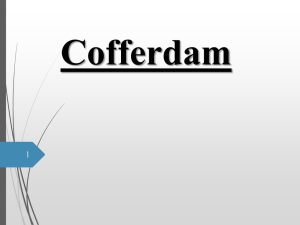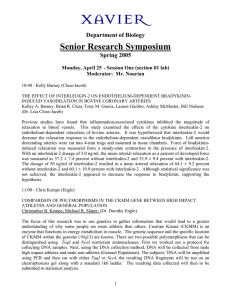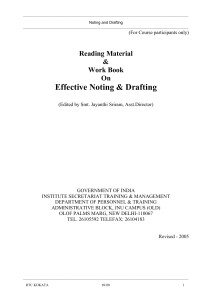Writing the Literature Review
advertisement
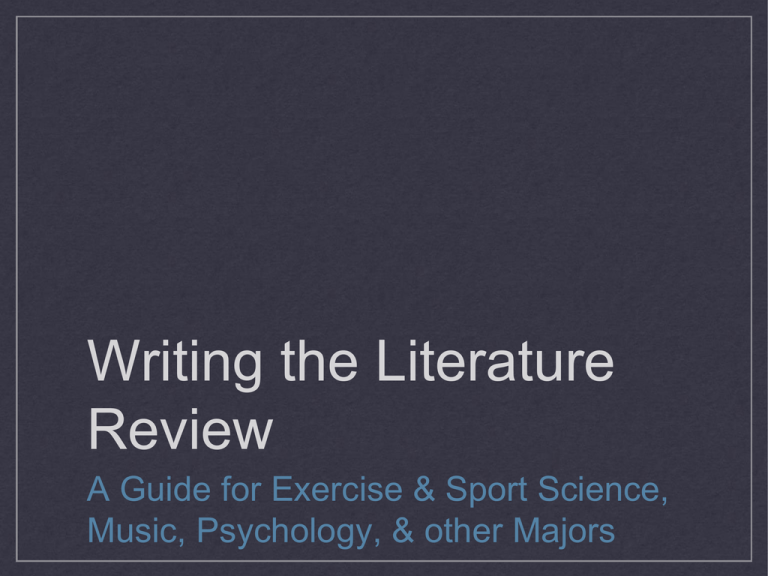
Writing the Literature Review A Guide for Exercise & Sport Science, Music, Psychology, & other Majors Literature Review A Process The literature review: A synthesis of studies on any given topic. Usually precedes a full-length original study as a way of introducing the general topic. Its purpose: To help the reader understand the background to your study and see how it’s the next logical study to be conducted in this domain. Necessarily, a good literature review requires a thoroughly researched topic. Be prepared for a writing process. Do not attempt to write a literature review over night. This process takes weeks and months. Yes, months. Literature Review: Preparations There are a number of preliminary steps to consider: Determine whether the literature review will be quantitative (must be theory-driven) or qualitative. Either choice will determine your emphasis on statistics. Topic selection and narrowing. Research, research, research . . . Topic Selection Work with your professor and/or research project mentor to select your topic. Examine a wide array of resources for ideas on topic selection: Textbooks Titles and abstracts of other articles Broad theories (as areas for exploration) Delimitations (to find a niche) Remember to brainstorm with other individuals. The Writing Center is awesome for this. Research Strategies Do not develop an outline at this stage. Research first. Outline later. Use RefWorks to help you keep your research organized. Be professional in your selection of sources. Peer-reviewed articles are a BIG deal. Databases are an enormous resource for a literature review assignment. PsychARTICLES, PsychINFO, ERIC, etc. Abstract databases are helpful; if used, be sure to order articles. You can’t cite from mere abstracts in your paper. You must read and cite the entire article. Cast your net wide. Remember to use your database’s thesaurus to explore more options for research. Use every search tool available to you. Google Scholar can be useful, if your professor allows Internet research. (Dr. Fox: No Internet Web sites!) Evaluating & Interpreting Research Ensure your information is both accurate and unbiased. Stick to peer reviewed sources only. (It’s worth repeating. ) Some Internet sources can be very up-to-date and therefore can be especially useful if statistics are required. (FedStats.gov, state government Web sites, etc.) Be guarded against any research that claims to “prove” an idea. Unequivocal results are rare. Consider each study’s methods, measurements, and significance to evaluate whether you should use it. Finally, take caution when you encounter research studies--especially qualitative research studies--that attempt to show causality. Organizing & Outlining Organization is key to the construction of an effective literature review. Let your outline flow from your research. Good organization begins with conscientious research. Take thorough research notes. Begin grouping your sources by topic, delimitation, and chronology. Make piles on a large table. Literally. Pay extremely good attention to key definitions as you do your research. Establish which studies are going to be most important for your review; take more thorough notes on these studies. However, avoid too many quotations in your notes. Dr. Fox allows only 1-2 quotations maximum! Learn how to paraphrase well. (The writing center can help!) Use RefWorks to keep all the information organized. Organizing & Outlining Create a topic outline before you begin drafting In your literature review’s Introduction: Identify the topic Establish the topic’s importance Define any crucial terms Engage in any theoretical discussions that are necessary for the logic of your literature review Arrange the raw research. This part of outlining will be considerably easier if you’ve done a good job organizing the data ahead of time (i.e., worked from piles!). Remember as you outline: Logical cohesion and flow are vital! Drafting Strategies Follow your topic outline as you write. Develop and maintain a logical progression (think: giant funnel). This paper is not a (glorified) list. Demonstrate consistencies in and relationships between the literature you’ve studied. Likewise, emphasize the stronger studies (e.g., have better measurements or more consistent methods) over ones that are weaker. Make the implications of your information and any suggestions for further research as specific as possible. A sample paragraph with transitions Researchers have conducted studies about siblings of special needs and autistic children because this group is vulnerable to adjustment difficulties (Cuskelly, 1999). In fact, specialists have compared the sibling-autism relationship to the MR relationship. They have also studied the importance of the family, and particularly the mother, in this relationship. In addition, Kaminsky and Dewey (2001) found that the autism-sibling relationship is characterized by less intimacy and pro-social behavior. This study likewise reports that these relationships were marked by fewer instances of quarreling. While this phenomenon may occur because of the unique situation of the autism-sibling relationship, less fighting is also a positive illustration of a relationship marked by more admiration. Furthermore, Rivers and Stoneman (2003) define this relationship as asymmetrical. These results are also similar to the MR-sibling relationship, as reported by Knott, et al. (1995). Rivers and Stoneman (2003) reveal, too, that parents worry about the autism-sibling relationship in their families. The importance of the family’s influence on the autism-sibling relationship is very useful for this research study and thus, will be discussed in the conclusion of the literature review. ~Ellen Geib, CU Writing Center Tutor Introduction & Conclusion Introduction: Explain literature review structure. Thesis: Establish the logical progression. Conclusion: Specifically identify the study that will follow (i.e., your original study!) as a result of this literature review. Drafting: Pitfalls to Avoid Unprofessional language: Avoid the appearance of cheekiness or emotional appeal. Don’t plagiarize! Be extremely careful with your paraphrasing. In fact, attend or view online the writing center’s workshop, Writing Papers with a Good Conscience! Too many quotations: Only quote those elements which need the utmost precision. In Dr. Fox’s class, one or two quotations max. Lack of Fluency and Cohesiveness: Your literature review should not read like a list of facts. Use transitions to develop fluency. APA headings do not substitute for transitions. Show connections between the literature Develop your thesis in the paper itself. Go Forth and Write! And come see us: MWF 1-5 p.m. T/TH 12:30-5 p.m. M-TH 7-11 p.m. Website Information Workshop Schedule, Power Point Presentations, & Videos: http://www.cedarville.edu/Offices/WritingCenter/Workshop-Information.aspx
